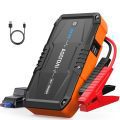This step-by-step guide provides a comprehensive approach to choosing the best wireless car audio receiver for your vehicle. It highlights essential features such as compatibility with your smartphone, sound quality, connectivity options, and user interface, ensuring you consider all relevant factors. By following this guide, you will be equipped to evaluate various models and make an informed decision that elevates your driving experience through improved audio connectivity and functionality.



Determine Your Audio Needs
Identify the audio sources you frequently use in your vehicle. If you primarily listen to music from your smartphone, ensure that the wireless car audio receiver supports Bluetooth connectivity for seamless pairing. Evaluate if you frequently use USB drives for music playback, as some receivers offer dedicated USB ports for direct access to your digital library. If you enjoy streaming services like Spotify or Apple Music, look for receivers that have built-in support for these apps. For example, a receiver with Apple CarPlay or Android Auto integration can enhance your experience by allowing you to control your music directly from your phone’s interface while driving.
Assess the sound quality you desire and any additional features that could enhance your driving experience. If you are an audiophile, select a receiver that supports high-resolution audio formats to ensure optimal sound reproduction. Investigate options with equalizer settings, which allow you to tailor the sound to your personal preferences. Additionally, consider specific functionalities like built-in navigation systems or hands-free calling capabilities, as these can add convenience and safety while on the road. For instance, a model with voice recognition can enable you to manage calls and navigation without taking your hands off the wheel, promoting a safer driving environment.



Research Compatibility
Check the specifications of potential receivers against your car model. Visit the manufacturer’s website or consult the product manual to determine the compatibility requirements for your vehicle. Look for details regarding dimensions, mounting depth, and dash kit compatibility. Note any specific features your car may require, such as steering wheel controls or integration with factory audio systems. Make a list of receivers that match these requirements, ensuring they are designed to work seamlessly with your model.
Examine the installation and wiring needs of the selected receivers. Consider the wiring harnesses required for a proper connection to your car’s existing audio system. Research whether you will need additional adapters or connectors for features like Bluetooth or auxiliary input. If you are not comfortable with the installation process, seek professional help or consult installation guides available online. Verify that the receiver you choose supports any unique features of your car, such as satellite radio or smartphone integration, to ensure a smooth upgrade to your audio experience.
Evaluate Audio Quality
Assess receivers that provide high-quality audio output. Prioritize specifications that are crucial for sound performance, such as signal-to-noise ratio (SNR). Aim for a receiver with an SNR of at least 90 dB, which indicates minimal background noise, allowing for clearer sound reproduction. Examine total harmonic distortion (THD) ratings as well; choose models with a THD of less than 1% to ensure that the audio remains true to the original recording without unwanted alterations.
Investigate the supported audio formats of each receiver. Look for compatibility with high-resolution audio formats like FLAC, ALAC, or DSD, which offer superior sound quality compared to standard formats. Review additional features such as built-in digital-to-analog converters (DAC) and upsampling capabilities, as these can enhance audio clarity and detail. Compare multiple models, taking notes on their specifications and features, to identify the receiver that best meets your audio quality needs.
Consider Connectivity Options
Examine the connectivity options available on the wireless car audio receiver. Look for Bluetooth capabilities to ensure seamless wireless connections with smartphones and tablets. Verify the range of Bluetooth connectivity; ideally, it should support the latest standards for better sound quality and reliability. Check if the receiver has Wi-Fi support, which can enhance streaming capabilities, allowing you to access internet radio and music services without relying solely on your mobile data.
Identify the presence of auxiliary inputs and USB ports, which provide additional ways to connect various devices. Make sure the auxiliary input is easily accessible for direct connections to devices that do not support Bluetooth. Review the number and type of USB ports available; some receivers may offer quick charging options or dedicated ports for specific functionalities. Consider these features:
- Bluetooth: Check for latest version support.
- Wi-Fi: Look for built-in capabilities for streaming.
- Auxiliary Input: Ensure easy accessibility.
- USB Ports: Verify quantity and charging options.
Read Reviews and Compare Models
Read user reviews on multiple platforms, such as retailer websites, forums, and social media. Focus on feedback that discusses performance, ease of use, and durability. Pay attention to recurring themes in the reviews, such as whether a model consistently performs well under specific conditions or if users report issues with usability. Look for detailed accounts that explain both positive and negative experiences. Highlight any features that are frequently praised or criticized, as this insight can be invaluable in understanding how a model truly performs in real-world scenarios.
Compare expert reviews from trusted sources, including technology websites and industry publications. Assess their findings on the same criteria you noted in user reviews: performance, ease of use, and durability. Take note of any side-by-side comparisons they conduct, as these can provide clear distinctions between models. Identify which models receive high ratings across various metrics, and consider any recommended alternatives if your initial choices fall short. Compile your observations to create a shortlist of models that fulfill your requirements based on comprehensive feedback from both users and experts.
Final Thoughts and Recommendations
In conclusion, selecting the ideal wireless car audio receiver is a straightforward process when you focus on your specific requirements and preferences. By assessing compatibility with your vehicle, prioritizing audio quality, exploring various connectivity options, and reviewing user feedback, you can make an informed decision. Investing time in this selection process will ultimately enhance your in-car audio experience, making every journey more enjoyable.






It’d be awesome if you could do a follow-up article on the best wireless car audio receivers for specific car models. Some receivers fit better in certain cars, and it would be cool to see some recommendations based on that!
Thanks for the suggestion! We’re definitely considering diving deeper into model-specific recommendations. Stay tuned!
For those looking to save some cash, keep an eye out for sales during holidays. I got my JVC KW-M150BT at half price during Black Friday, and it’s been fantastic!
I recently installed the Kenwood KDC-BT778HD in my car, and I love it! The sound clarity is so much better than my old receiver. Plus, the hands-free calling works like a charm. Thanks for the tips in this guide!
So glad to hear you found success with the Kenwood KDC-BT778HD! It’s a solid choice, and we’re thrilled the guide helped you make the right decision.
I wish this guide had a section on the installation process. Some receivers look easy to install, but I ended up needing a pro to do it. Tips for DIY installers would be super helpful!
I think the design of the receiver matters too! Sometimes the functionality is great, but if it doesn’t look good in your car, it can be a dealbreaker. Anyone else feel this way?
Absolutely, design can play a huge role in overall satisfaction. It’s important to find something that not only sounds good but also complements your car’s interior!
I followed this guide when I was looking to upgrade my car audio system. I ended up getting the Pioneer DEH-S8200BS, and it was a game changer! The sound quality is insane, and the Bluetooth connectivity is super reliable. Definitely recommend checking this guide out if you’re on the fence!
One thing I noticed is that some receivers have a lag when streaming music. Make sure to check for low latency options if you’re into gaming or want a seamless experience while driving!
Great point! Latency can be a real issue, especially for those who enjoy streaming. We’ll make sure to highlight that in future articles.